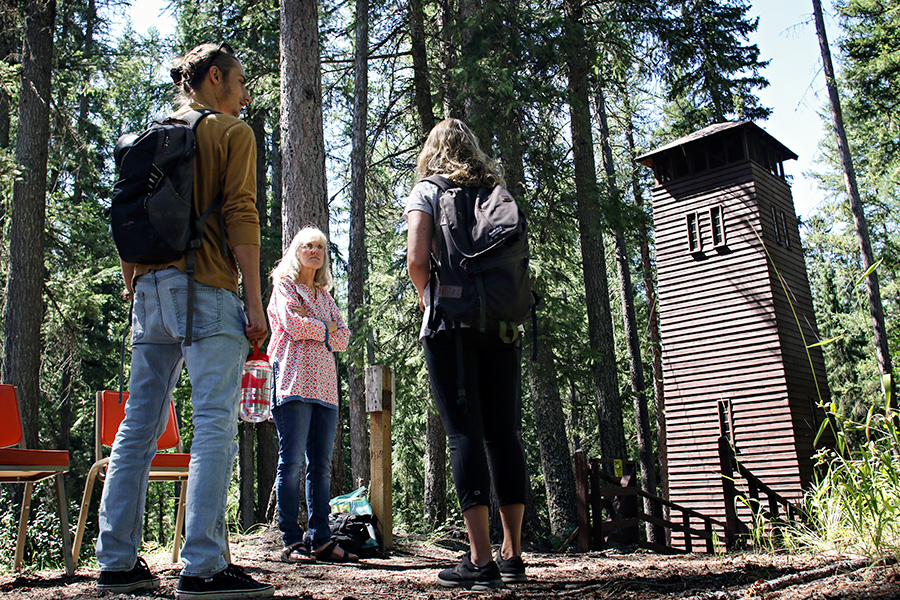Waterton-Glacier Park Rich in Science and History
Scientists and historians share latest project results with public at annual event
By Tristan Scott
The history of Glacier National Park viewed through the microscope lens of scientific research is a rich one indeed. Since before the park’s formation, researchers have flocked here to explore a mountain ecosystem that to this day remains relatively pristine and intact, and is home to some of the most unique species on the planet.
For more than a century, the wilds of Glacier Park have provided the ideal laboratory for the professionally curious — scientists and researchers seeking to unravel the mysteries that lie within one of the planet’s most fascinating expanses of wilderness.
Beginning in the 1950s, these pioneering biologists sought research permits and assembled teams to explore the park’s most iconic wildlife species — grizzly bears, mountain goats, bighorn sheep, and wolverines — and the results of those studies have held significant policy implications for Glacier and national parks in general.
But even before the permit system was in place, and prior to development of the park, scientists were making discoveries in the wilds of Glacier Park.
Those early researchers documented their findings to provide the first index of more than 1,000 different species of plants and hundreds of species of animals spread out across 1 million acres of wilderness.
With so much unknown, they were, quite literally, venturing into terra incognita.
Today, the spirit of pioneering scientific research is alive and strong, and on July 25 researchers and historians shared some of the latest results from projects in and around Waterton-Glacier International Peace Park at the annual Science and History Day, which alternates between the two national parks every other year.
Topics for the 2017 program included: changing landscapes in Glacier’s alpine; threats to meltwater stoneflies and other rare alpine insects; the history of West Glacier’s fire hose tower; and grizzly bear ancestry. Attendees also enjoyed a self-paced walking tour of the West Glacier Headquarters Historic District.
Glacier National Park Superintendent Jeff Mow said Science and History Day is an important conduit for the public to learn about the importance of understanding Glacier’s unique ecosystem, its suite of species and its rich history.
“This event is a unique opportunity to hear from park experts about a variety of topics,” Waterton Lakes National Park Superintendent Ifan Thomas said. “Joint research initiatives reflect our longstanding spirit of cooperation as the world’s first International Peace Park.”
For Tabitha Graves, a research ecologist with the U.S. Geological Survey’s Northern Rocky Mountain Science Center near Glacier’s west entrance, recent topics of interest have involved building a family tree of grizzly bears in an effort to answer ecologically critical questions about the ways bears interact with one another and the landscape.
“The grizzly family tree will allow us to answer the questions about dispersal, effective population size, similarity of diet and habitat between offspring and mothers, inbreeding, and the relationship between habitat and fitness,” Graves said.
In another recent study, Graves showed that the propensity for a grizzly bear to develop conflict behaviors with humans may be the result of social learning between mothers and cubs, as well as genetic inheritance — an important piece of information that could help inform the future of grizzly bear management and highlights the importance of minimizing human-wildlife conflict.
Once bears become accustomed to engaging in nuisance activities, they might pass the habits along to their cubs, perpetuating a dangerous cycle.
The study employed DNA testing of grizzly bear hair samples collected in southwestern Alberta, Canada. Graves and her fellow researchers sought out hair samples from natural rub objects like trees, power poles, fence posts, and barbed wire fence.
They evaluated a total of 76 mother-offspring relationships and 119 father-offspring relationships.
“There was no evidence that offspring were more likely to be involved in conflict behaviors when their fathers were problem bears,” the study notes. “In contrast, offspring were more likely to be involved in incidents or human-bear conflict when their mothers were problem bears.”
Graves said the study offers evidence that social learning might be amplifying the propensity for grizzly bear conflicts between bears and private landowners.
For more than four decades, Jack Potter, who retired as Glacier’s chief of the Division of Science and Resources Management, watched researchers make breakthrough discoveries that, big or small, impact the park’s future.
Potter worked at the park in 1973, when researchers learned that the boardwalk at Logan Pass had been built with wooden planks treated with pentachlorophenol. The chemical preservative was leaching into the groundwater and killing sub-alpine fir trees along the Hidden Lake Trail, and the boardwalk was rebuilt.
The ongoing research in fisheries has documented the long-term decline of bull trout, he said, and shows how exotic lake trout could out-compete the native trout species.
Continued monitoring and research is critical to the park’s future, he said, and an understanding and supportive public is instrumental.
“It’s so important that the public understands the significance of science in the park,” Potter said. “It will define our future.”